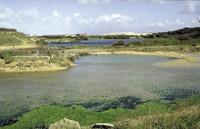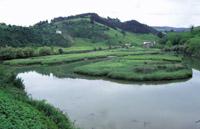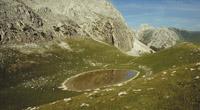Wetlands of the Basque Country (V): internal wetlands: peatlands
2000/09/01 Estonba Mintxero, Mikel Iturria: Elhuyar aldizkaria
Peatlands, in general, originate in the recesses of waterproof rocks such as sandstones, marbles or clays that keep the water level relatively high, so they are saturated zones of water. As a result of this water saturation, the oxygen is scarce and the diffusion is slow, where the low temperatures predominate, two factors that cause the decomposition of the humus by fermentation. The acids released in this process interrupt the bacterial activity and the organic matter remains unpruned, so they accumulate organic stones known as peat. Peat is very poor in some mineral nutrients (especially phosphorus and nitrogen), since in this acid soil that is produced from organic matter not completely decomposed, these elements are quickly lost. Therefore, carnivorous plants are common, since insects are the almost only sources of nitrogen in these poor areas. The anoxic and acidic conditions that prevail in peatlands make the objects that are trapped in these areas (powder of flowers, woods, remains of animals and plants...) remain in good condition despite spending time. Therefore, from the archaeological and paleoclimatological point of view, peatlands are places of great value. Thanks to this, in addition to being able to know the atmospheric characteristics of the Earth and the composition of the vegetation, some interesting data have been found to understand ancient human cultures.
However, depending on the substrate and the origin of water, different types of peatlands can be found with different concentrations of mineral nutrients and vegetable composition. In general, peatlands are divided into two main types: Peatlands of type bog, of type onbrotrophic or oligotrophic and peatlands of type Fen, minertrophic or eutrophic.
Bog-type peatlands are of an onbrotrophic or oligotrophic type, which originate in the recesses of waterproof rocks and which normally only receive rainwater. As for nutrients, these peatlands are usually quite poor. That is, the type of turbine predominant in the Basque Country and its origin must be sought in the cornices of the hills or slopes of little drainage that we have already mentioned.
Minertrophic or eutrophic peatlands type Fen: when they are peatlands located in the recesses of permeable rocks or in the proximities of the mountain streams, usually, in addition to rainwater, they also receive underground or runoff waters, so they usually contain more mineral nutrients. As for its origin, they are usually mountain lakes full of sediments, streams of soft slope or cornices of high humidity slopes.
Vegetation vegetation vegetation vegetation vegetation vegetation vegetation
Due to the special environmental conditions of peatlands, the vegetation that develops in them is also composed of species specially adapted to live in these harsh living conditions. In addition, as a result of these environmental conditions, it can be affirmed that they are islands of habitats for the maintenance of biodiversity, in which currently there are plant species recognized as true relics in glacial eras that are only found in these places. If to all this we add the different microhabitats that we find in the peatlands (plains of mosses, lagoons and small ponds, regattas…), the results from the point of view of the biomass are quite poor, but from the point of view of the biodiversity are ecosystems of great value. Unfortunately, this important natural value of peatlands has gone unnoticed so far, mainly due to its low ornithological interest.
Although there are significant differences in the peatlands that we find in the Basque Country, it can be said that, in general, its vegetation is organized in four vegetable rings: turbine proper of sphagnum, aquatic vegetation that develops in small streams of water and lakes, acidophile juncales and peatlands.
Own peatlands of esfagnos
The most important part of peatlands is formed by peat deposits formed by vegetable residues and, above all, by moss residues of the genus Sphagnum. In peatlands, while the inner part dies, the sphagnum form pillow structures that grow outward. These structures play an important role in controlling the flow of the streams and the regattas; when it rains, the water is absorbed and slowly released in the landings.
Sphagus have two types of cells: chlorocysts and hyalocysts. The first ones have cellular content and chlorophyll, so they perform photosynthesis. The second are hollow cells with pores. These last ones are precisely those that accumulate the water inside, but not only the water, since they actively trap the cations and release H+, which makes the water of the peatlands acierte.
In peatlands around 30 species of sphagnum can be found, along with vascular plant species such as Narthecium ossifragum, Hypericum elodes or Drosera, Utricularia or Penguin.
Aquatic vegetation of Turberas
The waters of the small streams of water or lakes of peatlands are oligotrophic and acidic, so in this habitat they live unique vegetable communities.
In these communities the algae have great importance. As for macroscopic algae, several species of the genera Chara and Nitella stand out. However, microscopic algae are the ones with the highest diversity. These microscopic algae live in different spatial compartments: some, which form phytoplankton, live floating in water, others live attached to other plants and form a compartment called peripheral. The last ones, which form the tetoplankton, inhabit the cavities of the millileaves of empty cells or mosses. Among them, we highlight the demidiaceae or cyanioids adapted to live in high levels of acidity. The latter, due to their ability to fix atmospheric nitrogen, can live in places where there are not many mineral nutrients.
As for vascular plants, however, the most abundant plant species are Hypericum elodes, Rannunculus flammula, Viola palustris, etc. In some peatlands, in addition, due to its scarce diffusion, one can observe the species of aquatic clover (Monyanthea trifoliata) considered as a high value plant.
Acidophile juncales
Although the soil humidity is high, the environmental conditions of the margins of the Turberas, which are not always stagnant, give rise to a community of plants called acidophile juncales, constituted mainly by species of reeds. The most abundant species in these vegetable communities are Juncus effusus, Juncus conglomeratus and Juncus acutiflorus. Together with them, in much less density, we find other plant species such as Senecio aquaticus, Carum verticillatum, Galium palustre, Eriophorum sp. etc.
Peatlands of peatlands
Finally, at the edges of the peatlands that are occasionally stagnated are developed heals formed mainly by Erica tetralix and Erica ciliaris. In these vegetable communities, in addition to soil moisture, atmospheric humidity is important, so these communities not only appear on the edges of peatlands, but also appear in abundant clouds and in the buds and high precipitation siliceous summits.
In these heals, in addition to the brezal species mentioned above, are frequent plant species such as the caerule Molinia, Calluna vulgaris, Gentiana neumonanthe, Pedicularis sylvatica, etc.
Fauna and fauna Fauna of the Andes
Traditionally, the importance of wetlands has been measured according to their ornithophynamic richness, so peatlands have not been properly valued in this area, as they do not accommodate, like most other types of wetlands, communities of abundant birds.
However, when analyzing the fauna of peatlands, it should be taken into account that as they are oligotrophic ecosystems, the animal communities will not be rich. Therefore, the importance of peatlands from the faunistic point of view should not be sought in large quantities of biomass, but in their originality and specialization. In this sense, the most remarkable difference would be the importance of peatlands for the reproduction of several species of amphibians. As is known, the initial stages of the life cycle of amphibians must necessarily occur in water. In addition, in most of the cases, these waters must be quite slow, so the high current waters of the streams and tails that dominate the mountains are not suitable. Therefore, the peatlands and other mountain wetlands analyzed below are essential for the reproduction of amphibians of the mountain.
In the waters of the peatlands, the following species of amphibians are reproduced: the ruby, the common frog, the common toad or the palate triton and the triton of the summits that maintain rare and scarce populations in the Basque Country, the red wild frog or the Iberian forest frog.
It is worth mentioning the importance of these means for different species of insects, especially for those that throughout their life cycle present an aquatic phase. Among this group, dentists (brooches and skewers) stand out. The species of dental easily observable in peatlands are Cordulegaster boltonii or Orthetrun coeruslescens. In addition, other species of other insect orders use peatlands to pass the aquatic stage of the life cycle, such as mosquitoes, emeras, etc.

Gai honi buruzko eduki gehiago
Elhuyarrek garatutako teknologia





